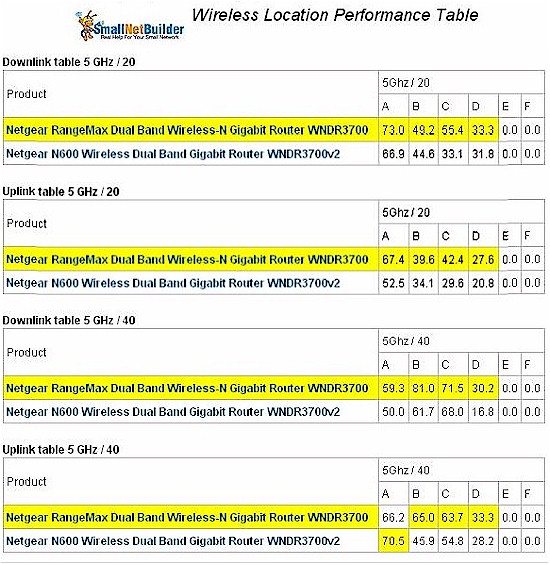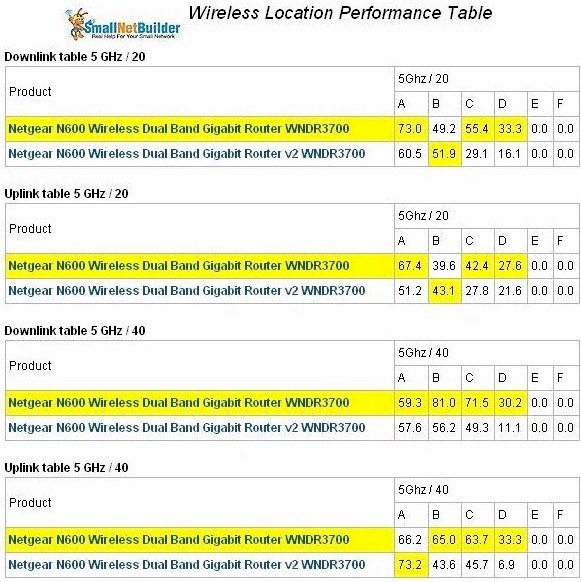I expected to hear from NETGEAR after the WNDR3700v2 review posted, given the poorer (vs. the original WNDR3700) 5 GHz band results. NETGEAR contacted me to say that my review had caused them to go back and take a look at other samples from their pilot manufacturing run, where my review sample came from.
NETGEAR explained in an email that some of the pilot run routers had "antenna placement issues" that sometimes produced "sub-optimal results". NETGEAR explained further during a phone call that it was actually antenna cable placement that caused some samples to have a cable pinched under a cover mounting post. High frequency RF doesn’t like things like pinched or sharply bent cables, so NETGEAR’s explanation made sense.
I opened my review sample and found no sign of cable damage. But I agreed to rerun the 5 GHz tests on a new test sample anyway. NETGEAR was about to release a new firmware revision (1.0.0.8), which was loaded on the new test sample. Since it is our policy to test products only with publicly-released firmware, NETGEAR didn’t send the sample until the firmware was released.
The 1.0.0.8 firmware documentation contains no reference to wireless performance improvements. But it does include Fixed “Application disconnection issue in every 5~10 minutes like Google talk, Battlefield, Starcraft, mIRC, AIM, ooVoo, etc.”, which may be of interest to some users.
Since I did not do a complete retest of both bands, I have not made a separate Wireless Chart entry and instead have substituted the new results for the old.
Wireless Performance
I retested the new v2 sample using our standard six-location open-air test. As with the original test, WPA2/AES encryption was enabled and I used Channel 36.
The test client was an Intel Wi-Fi Link 5300 AGN mini-PCIe card in an Acer Aspire 1810T notebook running Win 7 Home Premium and Intel’s Win 7 13.4.0.9 driver.
Figure 1 is a Wireless Performance table with the new retest data and the original WNDR3700 (v1) test results.

Figure 1: WNDR3700v1 and v2 wireless performance comparison – 5 GHz retest
Figure 2, copied from the WNDR3700v2 review, shows the original WNDR3700v2 5 GHz test data along with the WNDR3700v1 data.

Figure 2: WNDR3700v1 and v2 wireless performance comparison – 5 GHz original
Because you need to go back and forth to compare the WNDR3700v1, WNDR3700v2 and WNDR3700v2 retest results, I’ve pulled them into the tables below to ease your pain.
| Test | A | B | C | D | Avg | Diff |
|---|---|---|---|---|---|---|
| WNDR3700 v1 | 73.0 | 49.2 | 55.4 | 33.3 | 52.7 | |
| WNDR3700 v2 | 60.5 | 51.9 | 29.1 | 16.1 | 39.4 | +12% |
| WNDR3700 v2 – Retest | 66.9 | 44.6 | 33.1 | 31.8 | 44.1 |
Table1: 5 GHz band throughput comparison – Downlink, 20 MHz
| Test | A | B | C | D | Avg | Diff |
|---|---|---|---|---|---|---|
| WNDR3700 v1 | 67.4 | 39.6 | 42.4 | 27.6 | 44.3 | |
| WNDR3700 v2 | 51.2 | 43.1 | 27.8 | 21.6 | 36.0 | -5% |
| WNDR3700 v2 – Retest | 52.5 | 34.1 | 29.6 | 20.8 | 34.2 |
Table 2: 5 GHz band throughput comparison – Uplink, 20 MHz
| Test | A | B | C | D | Avg | Diff |
|---|---|---|---|---|---|---|
| WNDR3700 v1 | 59.3 | 81.0 | 71.5 | 30.2 | 60.5 | |
| WNDR3700 v2 | 57.6 | 56.2 | 49.3 | 11.1 | 44.0 | +13% |
| WNDR3700 v2 – Retest | 50.0 | 61.7 | 68.0 | 16.8 | 49.1 |
Table 3: 5 GHz band throughput comparison – Downlink, 40 MHz
| Test | A | B | C | D | Avg | Diff |
|---|---|---|---|---|---|---|
| WNDR3700 v1 | 66.2 | 65.0 | 63.7 | 33.3 | 57.1 | |
| WNDR3700 v2 | 73.2 | 43.6 | 45.7 | 6.9 | 42.4 | +18% |
| WNDR3700 v2 – Dell Mini | 70.5 | 45.9 | 54.8 | 28.2 | 49.9 |
Table 4: 5 GHz band throughput comparison – Uplink, 40 MHz
I’ve also calculated average throughput for the four test locations in each test run, which is in the Avg column and the difference between the averages for the v2 original and retest results, in the Diff column.
Using the difference calculation shows that performance did improve with the retest in three out of four cases.
Here are links to the original test IxChariot wireless test plots if you’d like to explore further:
- 5 GHz / 20 MHz downlink
- 5 GHz / 20 MHz uplink
- 5 GHz / 20 MHz up and downlink
- 5 GHz / 40 MHz downlink
- 5 GHz / 40 MHz uplink
- 5 GHz / 40 MHz up and downlink
And the retest:
- 5 GHz / 20 MHz downlink
- 5 GHz / 20 MHz uplink
- 5 GHz / 20 MHz up and downlink
- 5 GHz / 40 MHz downlink
- 5 GHz / 40 MHz uplink
- 5 GHz / 40 MHz up and downlink
Closing Thoughts
I can’t really say exactly what accounts for the the slight performance improvement in the retest. I don’t think that NETGEAR cherry-picked a router for the retest. But I’m sure they tested it before they sent it, to be sure that it was properly performing.
As I said, I didn’t see any of the alleged cable pinching in my original review sample and the quick peek I took inside the retest sample showed the new 5 GHz antennas in the same position as the original sample and the cables appeared to be nowhere within pinching distance of the cover mounting post.
At any rate, the retested v2, although better, still doesn’t beat the original’s performance. And that’s where I’m going to leave it.
